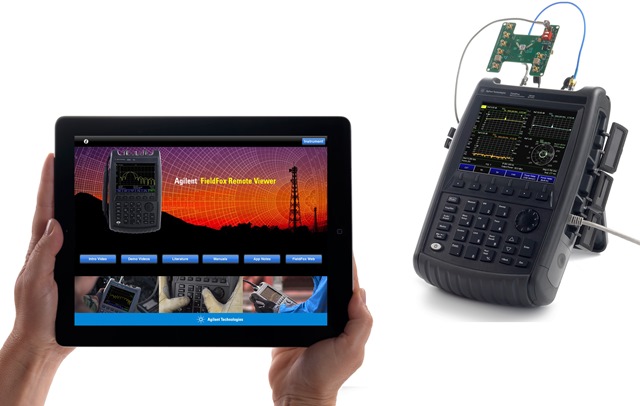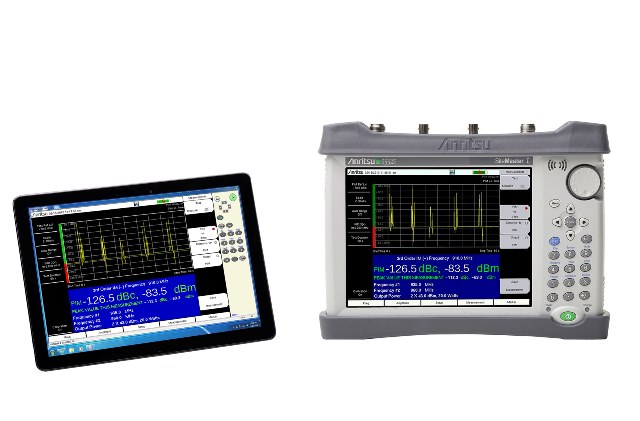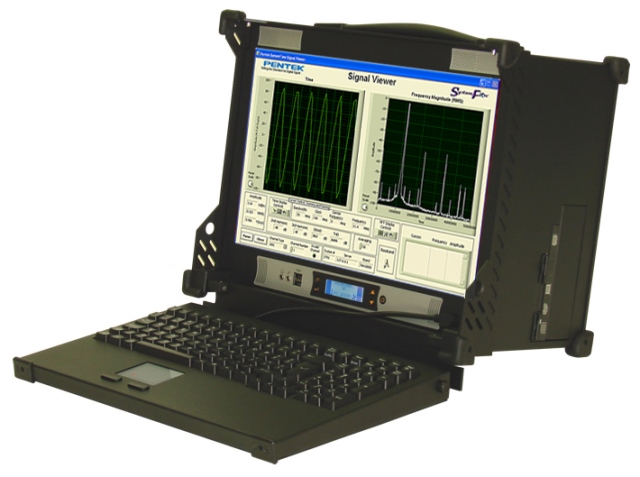BY RICHARD COMERFORD
With widespread deployment of RF systems such as celluar and radar equipment in some of the most remote locals on earth, field engineers and technicians often need to be able to perform sophisticated RF measurements in places and under conditions that can best be described by the expression, “I wouldn't send a dog out on a night like this.” Yet these systems are so critical to business and everyday life that not maintaining them is not an option.
Recently, a number of instrumentation companies have introduced ways to ease the burden on field personnel by allowing them to control RF equipment remotely, say from within the comfort of a truck cab, while the instrumentation is doing its job in precarious locations and/or exposed to the elements.
For example, with Option 030, the FieldFox handheld analyzers from Agilent Technologies (www.agilent.com) can now be remotely controlled via an iOS device such as an iPad or iPhone, which enables viewing and control of the instrument via the Remote Viewer iOS app. With a wireless LAN or cellular broadband data connection and an iOS device, the analyzers can now be placed in areas where users do not wish to stay long due to extremely harsh or unsafe conditions. Additionally, if one technician or engineer has trouble making a measurement or determining the source of a problem, another can step in to remotely troubleshoot and solve the problem. Once users launch the Remote Viewer, they can also access technical literature such as user guides, application notes, and datasheets, as well as demo videos. This lets users quickly find the data they need to resolve network issues as they arise in the field.

FieldFox handheld analyzers can now be operated remotley using iPads or iPhones
Also new to the instrument are a spectrum analysis time-gating option (Option 238) and support for Agilent's USB peak-power sensors (Option 302). The spectrum analysis time-gating function is specifically geared toward engineers testing the pulse characteristics of their radar systems. Unlike competing solutions, the instrument's time-gating function allows users to view both frequency and time domain at the same time, and it can measure very narrow pulses (less than 1us wide) with sweep time as small as 8 us. Enhanced trigger functions (burst trigger and pre-trigger, for example) further ease the signal-measurement challenge.
Peak power measurements are needed to test pulsed transmissions. The power meter option supports Agilent USB peak-power sensors so engineers can measure peak and average power to 18 or 40 GHz with the same accuracy as with traditional peak-power meters. By extending frequency measurements to 40 GHz , the power meter option suits engineers maintaining and troubleshooting radar communications equipment and networks.
Anritsu (www.anristsu.com) has also introduced remote capability, in the form of its Wireless Remote Tools for its touchscreen PIM Master, Site Master, Spectrum Master, and VNA Master handheld instruments. With the software installed, field technicians and engineers can remotely view screens and control the industry-leading field instruments using a Windows-based tablet, laptop, or PC to simplify deployment and maintenance of 2G/3G/4G wireless networks.

A number of portable instruments from Anritsu, such as the SiteMaster seen here on the right, can be operated remotely using a Windows-based tablet or other WIndows device.
Available for free download from the Anritsu Tool box web page, Wireless Remote Tools makes conducting field measurements, such as sweeps, spectrum analysis, PIM, and S-parameters, easier and more efficient. For example, operators can now remain on the ground and use a Site Master cable-and-antenna analyzer to conduct sweeps on jumpers at the top of the tower. Remote spectrum monitoring can also be done more effectively, especially if the interference is caused by an intermittent signal. Users can now monitor and control a Spectrum Master handheld spectrum analyzer at a remote location, such as a desk, using the software.
Wireless Remote Tools initially supports the Site Master S331E/S332E and S361E/S362E; VNA Master MS2024B/MS2025B and MS2034B/MS2035B handheld vector network analyzers; Spectrum Master MS2712E/MS2713E and MS2720T; and PIM Master MW82119A Passive Intermodulation analyzer. The handheld instruments can be connected remotely via a Wi-Fi link using a pocket Wi-Fi router for local remote control or from the Ethernet port on the analyzer through the Internet.
The Model RTR 2727 Talon RF/IF signal recording and playback system from Pentek (www.pentek.com) is a rugged portable recorder suitable for military and aerospace applications. The system features recording and playback of IF signals up to 700 MHz with signal bandwidths to 200 MHz, and it can be configured with 500-MHz 12-bit A/Ds or 400-MHz 14-bit A/Ds and an 800 MHz 16-bit D/A. Available I/O includes audio and VGA video, RS-232/422/485 serial, multiple USB 2.0 and 3.0, eSATA, and dual Gigabit Ethernet connections.

Pentek's Model RTR 2727 Talon RF/IF signal recording and playback system's software lets users set the system up for turnkey operation and remote control
The instrument's SystemFlow software allows turnkey operation through a graphical user interface, while the SystemFlow application programming interface allows remote system control and integration of the recording software into custom applications. The software also includes a virtual oscilloscope and spectrum analyzer to monitor signals before, during, and after data collection. Recorded files are stored in the native Windows NTFS format, allowing them to be used without post-recording file conversion.
At the heart of the recorder are the Cobalt Series Virtex-6 software-radio boards featuring A/D and D/A converters, DDCs and DUCs (digital down- and up-converters), and FPGA IP. Optional GPS time and position stamping can capture that critical signal information within the recording. The recorder has up to eight shock- and vibration-resistant hot-swap SSDs with a combined capacity to 3.8 Tbyte, front panel USB ports, and I/O connections on the side panel, all in a 100% aluminum alloy case reinforced with shock absorbing rubber corners and an impact-resistant protective screen.
Advertisement





